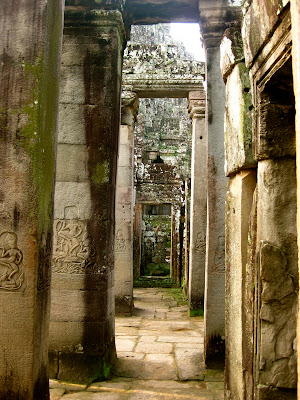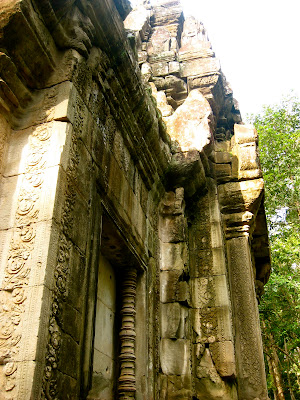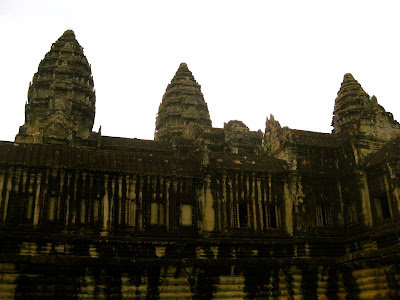We were very sad to leave Don Det but we had to move on, and the prospect of meeting our friends J and Lindsay on the 16th for a week made us excited, so we pushed on..
We left Don Det on the 14th thinking we had 2 days to cross the border and stay in one of the towns on the way to Siem Reap, we chose Kratie as we heard you could see the rare Mekong Irrawaddi Dolphins there - and it was around a 6hr journey which made it about half way to Siem Reap.
So on the bus and nearly at Kratie the driver decides to tell us that there is a 3 day festival over the whole country and once we get to Kratie we wont be able to leave for 3 days as lots of business close and everyone enjoys the festival. So we made a quick decision and decided to continue on to Siem Reap with some of the other passengers on the bus.
It was a long journey we left Don Det in Laos at around 8am and finally after changing buses 4 times and stopping for breaks and visa stuff, we arrived in Siem Reap at around 12am.
As we arrived so late we aloud ourself to be taken to the first hotel that was offered. It had a pool and was only $8 a night for a double room but the staff were really unfriendly and it was a bit out of the main area, so we decided to stay there for 2 nights and move for the 16th when J & Lindsay arrived, to a nicer hotel in town.....

Most hotels have signs saying no drugs, food or prostitutes and keep the noise to a minimum....
This meant i had to get rid of my big bag of hand grenades i was carrying.

John and I had to sample the local cocktails, the one on the left is
a Kompot Pepper mojito, made with the famous fresh pepper corns from
the region of Kampot.


We checked out a few bars in town, our fav was Angkor What?

J & L arrived on the eve of the 16th and on the 17th we decided to book a Tuk Tuk driver to take us round the temples of Angkor for the whole day for just $15 between us. Da (the tuk tuk man) picked us up from our hotel at 5am and we watched the sun rise over Angkor Wat .......
Having breakfast
map of Angkor Temples
Next we went to Bayon. Apparently......according to wikipwedia this temple is a well-known and richly decorated Khmer temple at Angkor. Built in the late 12th century or early 13th century as the official state temple of the Mahayana Buddhist King Jayavarman VII, the Bayon stands at the centre of Jayavarman's capital, Angkor Thom. Following Jayavarman's death, it was modified and augmented by later Hindu and Theravada Buddhist kings in accordance with their own religious preferences.
The Bayon's most distinctive feature is the multitude of serene and massive stone faces on the many towers which jut out from the upper terrace and cluster around its central peak.

It had amazingly well preserved carvings

The iconic faces of Bayon
The central structure of the temple is so intricate, it would have had a complicated network of walk ways and passages.
Can you imagine what this extravagant temple looked like when it was built over 800 years ago?




Next we had a look at Baphuon, it wasn't that far a walk but it was sooooo hot & humid.
Baphuon ---------------------->

Baphuon is located in Angkor Thom, northwest of the Bayon. Built in the mid-11th century, it is a three-tiered temple mountain built as the state temple of Udayadityavarman II dedicated to the Hindu God Shiva.
It is the archetype of the Baphuon style.... wiki said... The temple adjoins the
southern enclosure of the royal palace and measures 120 metres east-west
by 100 metres north-south at its base and stands 34 meters tall without
its tower, which would have made it roughly 50 meters tall. In the late 15th century, the Baphuon was converted to a Buddhist
temple. A 9 meter tall by 70 meter long statue of a reclining Buddha
was built on the west side's second level, which probably required the
demolition of the 8 meter tower above, thus explaining its current
absence. The temple was built on land filled with sand, and due to its
immense size the site was unstable throughout its history. Large
portions had probably already collapsed by the time the Buddha was
added.
Prasat suor Prat ....The Prasats Suor Prat are the twelve rugged looking
towers in laterite and sandstone which line the eastern side of the royal square
in Angkor Thom and the start of the road leading to the Victory Gate, on either
side of which they are symmetrically arranged. Their function remains unknown,
since their romantic name, which corresponds to the local belief that they were
used to support a high wire stretched between them for acrobatics during certain
festivals, is probably irrelevant, one theory is When two men dispute over some unknown
matter, each of the contestants is forced to sit in one of them while the relatives
stand watch at the base. After three or four days, he who is wrong shows it
by suffering some illness - ulcers, or catarrh, or malignant fever - while the
other remains in perfect health. Thus right or wrong is determined by what is
called 'divine judgement'..."

Phimeanakas temple is a Hindu temple in the Khleang style, built at the end of the 10th century, during the reign of Rajendravarman (from 941-968), then rebuilt by Suryavarman II in the shape of a three tier pyramid as a Hindu temple. On top of the pyramid there was a tower.
According to legend, the king spent the first watch of every night with a woman thought to represent a Nāga
in the tower, during that time, not even the queen was permitted to
intrude. Only in the second watch the king returned to his palace with
the queen. If the Naga who was the supreme land owner of Khmer land did
not show up for a night, the king's day would be numbered, if the king
did not show up, calamity would strike his land.
Even the ancient Cambodians needed bins....


Preah Palilay temple
The entrance and walkway guarded with 7 headed Naga ....
Buddhist shrine still in use at Preah Palilay
 |
| Preah Palilay, Angkor |
 |
| Preah Palilay, Angkor, Siem Reap |
 |
| Preah Palilay, Angkor, Siem Reap |
 |
| Preah Palilay, Angkor, Siem Reap |
 |
| Preah Palilay, Angkor, Siem Reap |
Ta Phrom built in the Bayon style largely in the late 12th and early 13th centuries and originally called Rajavihara. Located approximately one kilometre east of Angkor Thom and on the southern edge of the East Baray, it was founded by the Khmer King Jayavarman VII as a Mahayana Buddhist
monastery and university. Unlike most Angkorian temples, Ta Prohm has
been left in much the same condition in which it was found: the
photogenic and atmospheric combination of trees growing out of the ruins
and the jungle
surroundings have made it one of Angkor's most popular temples with
visitors.UNESCO inscribed Ta Prohm on the World Heritage List in 1992.
Today, it is one of the most visited complexes in Cambodia’s Angkor
region.
This temple has been used in a Hollywood production, the famous 2001 film, Tomb Raider.
 |
| Ta Phrom, Angkor, Siem Reap |
 |
| Ta Phrom, Angkor, Siem Reap |
 |
| Ta Phrom, Angkor, Siem Reap |
 |
| Ta Phrom, Angkor, Siem Reap |
 |
| Ta Phrom, Angkor, Siem Reap |
 |
| Ta Phrom, Angkor, Siem Reap |

 |
| Ta Phrom, Angkor, Siem Reap |
 |
| Ta Phrom, Angkor, Siem Reap |
 |
| Ta Phrom, Angkor, Siem Reap |
 |
| Ta Phrom, Angkor, Siem Reap |
 |
| Ta Phrom, Angkor, Siem Reap |
 |
| Ta Phrom, Angkor, Siem Reap |
 |
| Ta Phrom, Angkor, Siem Reap |
 |
| Ta Phrom, Angkor, Siem Reap |

ANGKOR WAT.....(wikipedia says')
is the largest Hindu temple complex in the world. The temple was built by King Suryavarman II in the early 12th century in Yasodharapura - present-day Angkor, the capital of the Khmer Empire, as his state temple and eventual mausoleum. Breaking from the Shaivism tradition of previous kings, Angkor Wat was instead dedicated to Vishnu.
As the best-preserved temple at the site, it is the only one to have
remained a significant religious centre since its foundation – first
Hindu, dedicated to the god Vishnu, then Buddhist. The temple is at the top of the high classical style of Khmer architecture. It has become a symbol of Cambodia, appearing on its national flag, and it is the country's prime attraction for visitors.
It is designed to represent Mount Meru, home of the devas in Hindu mythology: within a moat and an outer wall 3.6 kilometres (2.2 mi) long are three rectangular galleries, each raised above the next. At the centre of the temple stands a quincunx of towers. Unlike most Angkorian temples, Angkor Wat is oriented to the west; scholars are divided as to the significance of this. The temple is admired for the grandeur and harmony of the architecture............................................... and because it is so damn old!


 |
| view looking out of Angkor Wat |


 |
| End of a big day!!!! |



















































































No comments:
Post a Comment